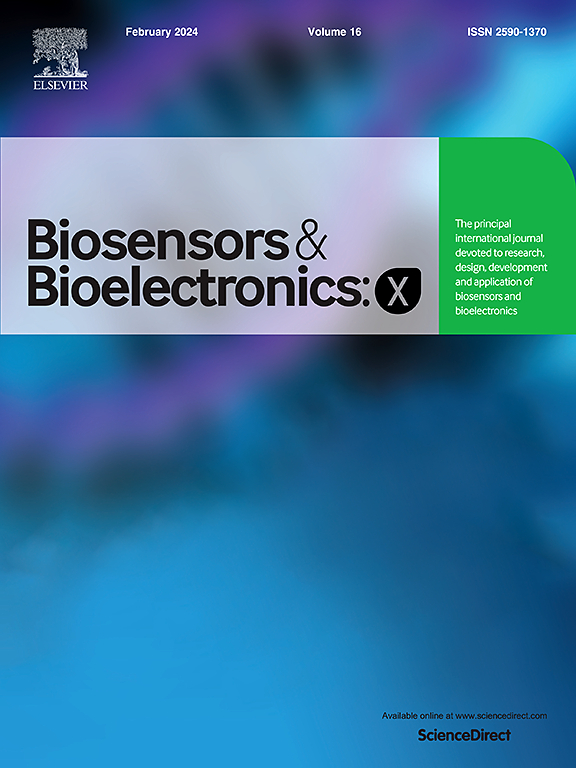Longitudinal tracking of chronic inflammation through Calprotectin and Interleukin-6 using a sweat wearable device
IF 10.61
Q3 Biochemistry, Genetics and Molecular Biology
引用次数: 0
Abstract
This work demonstrates a continuous, noninvasive two-plex electrochemical biosensor for the measurement of inflammation in sweat via disease-specific and general markers Calprotectin and Interleukin-6 (IL-6), respectively. Sensor functionalization and sensor stability was characterized through Fourier Transform Infrared (FTIR) spectroscopy. Sensor stability was characterized through open circuit potential and electrochemical impedance spectroscopy (EIS). On-body stability was demonstrated through relative humidity and temperature measurements of the sensor-skin interface.
Calprotectin and IL-6 were measured in sweat over 2 days from 2 chronically inflamed subjects and 10 healthy subjects to characterize dual sweat expression of the markers and investigate diurnal patterns of expression across the two groups. Sweat Calprotectin was continuously tracked over a 40-h period for chronically inflamed and healthy subjects with different inflammatory activity and treatments. Sensor measurements were recorded continuously with a sampling rate of 1–1.5 min.
Significantly higher sweat Calprotectin and higher median sweat Calprotectin expression was observed in the morning-afternoon than in the evening among inflamed and healthy subjects, respectively. Higher median sweat IL-6 was observed in inflamed individuals in the morning-afternoon, while higher median sweat IL-6 was observed in healthy individuals in the evening. Temporal results of sweat Calprotectin tracking demonstrate higher basal Calprotectin in an unmedicated over a medicated inflamed subject, and higher basal Calprotectin of inflamed subjects over a healthy subject.
Calprotectin and IL-6 demonstrated a strong positive linear relationship in sweat. Diurnal patterns were observed in the sweat of inflamed and healthy individuals, and continuous tracking of disease-specific inflammation through sweat Calprotectin was demonstrated.
使用汗液可穿戴设备通过钙护蛋白和白细胞介素-6纵向跟踪慢性炎症
这项工作展示了一种连续的、无创的双路电化学生物传感器,分别通过疾病特异性和一般标记物钙保护蛋白和白细胞介素-6 (IL-6)来测量汗液中的炎症。利用傅里叶红外光谱(FTIR)表征了传感器的功能化和稳定性。通过开路电位和电化学阻抗谱(EIS)表征了传感器的稳定性。通过传感器-皮肤界面的相对湿度和温度测量证明了身体稳定性。研究人员在2天内测量了2名慢性炎症受试者和10名健康受试者的汗液中钙保护蛋白和IL-6的含量,以表征这两种标志物的双汗液表达,并研究两组之间的日表达模式。采用不同的炎症活动和治疗方法,对慢性炎症和健康受试者的汗液钙护蛋白进行了40小时的连续追踪。传感器测量以1-1.5分钟的采样率连续记录。在炎症和健康受试者中,上午至下午的汗液钙保护蛋白和汗液钙保护蛋白的中位数表达量分别高于晚上。炎症个体在上午至下午的汗液中IL-6值较高,而健康个体在晚上的汗液中IL-6值较高。汗液钙保护蛋白追踪的时间结果显示,未服药的炎症受试者的基础钙保护蛋白高于服药的炎症受试者,炎症受试者的基础钙保护蛋白高于健康受试者。钙保护蛋白和IL-6在汗液中表现出强烈的正线性关系。在炎症和健康个体的汗液中观察到昼夜模式,并通过汗液钙护蛋白连续跟踪疾病特异性炎症。
本文章由计算机程序翻译,如有差异,请以英文原文为准。
求助全文
约1分钟内获得全文
求助全文
来源期刊

Biosensors and Bioelectronics: X
Biochemistry, Genetics and Molecular Biology-Biophysics
CiteScore
4.60
自引率
0.00%
发文量
166
审稿时长
54 days
期刊介绍:
Biosensors and Bioelectronics: X, an open-access companion journal of Biosensors and Bioelectronics, boasts a 2020 Impact Factor of 10.61 (Journal Citation Reports, Clarivate Analytics 2021). Offering authors the opportunity to share their innovative work freely and globally, Biosensors and Bioelectronics: X aims to be a timely and permanent source of information. The journal publishes original research papers, review articles, communications, editorial highlights, perspectives, opinions, and commentaries at the intersection of technological advancements and high-impact applications. Manuscripts submitted to Biosensors and Bioelectronics: X are assessed based on originality and innovation in technology development or applications, aligning with the journal's goal to cater to a broad audience interested in this dynamic field.
 求助内容:
求助内容: 应助结果提醒方式:
应助结果提醒方式:


